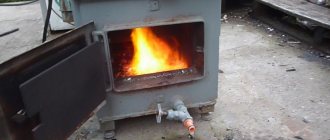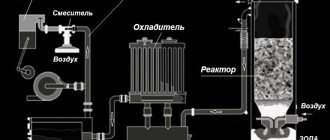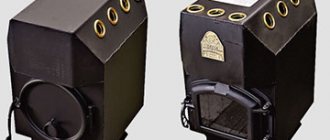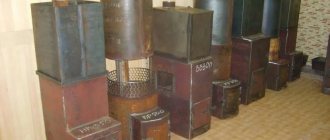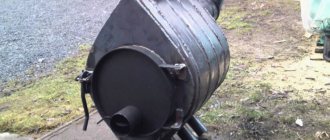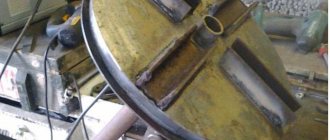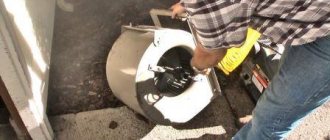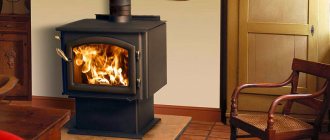Here you will learn:
- How does a pyrolysis oven work?
- Main types of furnaces
- How to make a pyrolysis oven with your own hands
- Stove modernization
Solid fuel heating equipment will always be in demand. There are places where gas may never appear. In some settlements, gas supply is planned for the next 10-15 years. Some people just like to heat with wood, while others use wood stoves to heat their baths. A pyrolysis oven is an ideal option for heating rooms for any purpose. It can be made of metal or brick. Our review-instructions will tell you about the manufacturing process.
How to make a pyrolysis boiler with your own hands, step-by-step instructions and drawings
How and from what to assemble a pyrolysis boiler for domestic use with your own hands is the topic of the proposed article-instructions.
Operating principle of pyrolysis boilers
High efficiency, therefore, economical fuel consumption in such installations is achieved by dividing the combustion chamber into 2 compartments. There are several designs of pyrolysis furnaces. For example, this.
Upper chamber. Fuel is loaded into it and burned. The peculiarity is that it is necessary to ensure a lack of oxygen. Under this condition, the process of decomposition of the product slows down, but in fact, only its charring occurs (economical consumption!) and increased gas formation is initiated. Actually, this is what is called pyrolysis.
Down Cam. It receives volatile substances from the 1st compartment, which, due to additional air supply, burn, releasing heat. Only a small part of it is spent on maintaining the pyrolysis process, and the rest goes to heating the coolant.
The figure clearly illustrates the main operating cycles of a pyrolysis boiler.
In some models, the cameras are located on the same level.
Actually, the point is not in the engineering solution, but in assembling an installation in which the pyrolysis process can be implemented, that is, to ensure long-term combustion of fuel. And the choice of a specific scheme is at the discretion of the master.
Features of manufacturing a pyrolysis boiler
Materials
It is better to make the body of the pyrolysis boiler from sheet steel (from 2 mm, depending on the design power). Boiler models that are assembled from thick-walled pipes are hardly suitable for heating a private home. Basically, such installations are used to heat various utility rooms, garages or temporary sheds.
Larger pyrolysis boilers are mounted like most heat generators - rectangular in shape. In some cases, if the model is powerful, it is advisable to line its walls (inside) with fireclay bricks.
Dimensions of pyrolysis boilers
One of the most interesting and “mysterious” questions on this topic. All calculations are made in relation to a specific house, its heating system, with all its nuances, diagrams, and so on. The author will not provide mathematical calculations and asks you to take his word for it. It is better to entrust the design of a pyrolysis boiler to a specialist. Developing documentation costs money, but in any case it will cost less than purchasing an industrial-made installation.
Specifics of operation of pyrolysis boilers
Without knowing some of the nuances of using such equipment, it makes no sense to start manufacturing such a model of a heat generator.
Quite “strict” criteria for the moisture content of burned fuel. For example, for firewood the maximum value is 33±2%. What is this connected with? An increase in temperature initiates the evaporation of moisture contained in the product. Naturally, the steam will begin to mix with pyrolysis gases and negatively affect the intensity of the combustion process. The use of wet fuel sharply reduces the efficiency of the installation.
Not all types of solid fuel are suitable for combustion in pyrolysis boilers. Taking into account the specifics of their work, only materials characterized by high gas formation during combustion can be used. The lack of volatile substances affects the operating efficiency of pyrolysis models. Simply put, a lot of firewood is consumed, but the benefits are minimal.
In conclusion, we can point out that the cheapest model (and of low power) costs around 48,000 rubles. In conclusion, we can point out that the cheapest model (and of low power) costs around 48,000 rubles. And it is not a fact that such a pyrolysis installation will completely suit the owner. For example, dimensions in accordance with the chosen installation location. If you think about it, making a pyrolysis boiler with your own hands, according to individual drawings, is a good solution to the problem of heating a private house, especially if it is impossible to connect it to the gas supply line.
Negative effects of reduced loads
In addition, during calculations, one should take into account the negative impact on the entire fuel system of working with a reduced load.
Features of the wood pyrolysis process
When burning wood, the full potential of the fuel is not used, since the wood burns quite quickly. Because of this, the combustion process is significantly more difficult, because you constantly have to add firewood to the boiler or stove. For this purpose, a long-burning furnace was designed by Belyaev, Popov and Kholmov.
Pyrolysis creates conditions for the fuel where wood combustion slows down and much more heat is released. Prolonged combustion is achieved by reducing the oxygen supply. As a result, natural coke and flammable gas are formed. This gas mixes with oxygen and also burns under high temperatures, releasing quite a lot of heat.
Pyrolysis stages:
- With minimal access to oxygen, wood burns and releases flammable gas;
- The flammable gas burns in the afterburner chamber, releasing heat.
Two-stage pyrolysis combustion is widely used in long-burning furnaces and solid fuel generators. This is how you can build a gas generator boiler for a car
But it is important to set up the boiler correctly
The cost of industrial elements can be high. To construct such a boiler, high-quality and expensive refractory materials are required. In addition, industrial boilers have an effective automatic system.
Combustion control occurs by controlling the air supply. Oxygen can be supplied by a fan. It works by connecting to the mains. When installing a fan, you receive an installation that is dependent on the electrical network.
Potbelly stove
Such an example would be a simple potbelly stove with a divided firebox. To be honest, this furnace performs the function of pseudo-pyrolysis, since its simple design is very far from the described theory of thermal destruction of organic raw materials with separate combustion of its products. The partition separating the firebox simulates the possibility of two separate processes, gas generation and afterburning. The presence in this case of nozzles supplying additional air gives a very dubious opportunity for the smoldering products to fully burn. This happens due to the main flame, or does not happen at all.
To manufacture such a “gas” stove, minimal alterations in the design are required. A metal plate is welded into the firebox space and you can consider yourself “ahead of the rest.” Some improvement as a result of such alterations is of course possible. But it will consist in a banal lengthening of the path traversed by hot gases. The need for pyrolysis in a brick kiln, in my opinion, is very doubtful. A medium-sized heating and cooking stove, with channels built into the wall, has very good performance characteristics, which I can verify as a user. Building such a brick structure requires more knowledge and additional materials. Non-standard dimensions and the danger of carbon monoxide penetration do not imply its placement in a residential area. Application for industrial needs is a completely different matter. Firing of clay products or tempering of metal is possible. There is a large cavity inside for holding ceramics and a high temperature can be maintained for a long time.
Device
You can see what it looks like in the photo. A classic pyrolysis oven has two chambers. One is used for fuel and is hermetically sealed to prevent oxygen from getting inside. Firewood is ignited manually or with a torch. The resulting gas (nitrogen with a mixture of hydrogen, methane, carbon dioxide and carbon dioxide) passes into the second chamber, into which oxygen is supplied to improve combustion. The separation of the chambers is carried out by a grate with stacked briquettes.
The second chamber can be combined with a chimney. It can operate using sealed dampers, taking into account natural draft, or using a fan.
Scheme of operation of a pyrolysis boiler
To extract solid residues, a retort is used, which is a round part of the body. Firewood is placed in it, and coal and coke are taken out from below.
What is the difference between a pyrolysis oven and a conventional one? In it, the fuel does not burn immediately, but goes through two stages, leaving behind gas and solid residues. The latter are also burned, which increases the amount of heat generated. As a result of all these processes, little remains of the firewood - a little ash. Therefore, oven cleaning is required quite rarely - sometimes once a week is enough.
Safety
Making a pyrolysis oven with your own hands is quite possible, but it is important to make a detailed drawing and also have the skills to work with a welding machine. Since gas formation occurs unevenly, monitoring of the gas to oxygen ratio is required. For this, electronics are used that monitor the processes. One chamber generates pressure, the other creates a balance in the composition of the air-fuel mass. This is the difference between designs made at the factory and those made by hand.
Safe models of pyrolysis boilers
Note: Since the pyrolysis process is not controlled, it requires the use of an electronic system. To build a stove with your own hands, you should use high-quality materials.
A small pyrolysis oven that can be used in a garage
Making your own oven
A household oven operating on the principle of pyrolysis is suitable for:
- Dachas;
- At home;
- Hiking conditions;
- Baths;
- Garage;
- Other residential buildings.
When making a pyrolysis furnace with your own hands, it is important to calculate the proportion of gas with oxygen, the dimensions of the structure and the required power
What tools and materials will be needed
To install a household pyrolysis oven you will need the following list of materials and tools:
- Apparatus for welding parts;
- Electric drill;
- Bulgarian;
- Electrodes;
- Cutting wheel 240 mm;
- Grinding wheel 135 mm;
- Metal sheets 4 mm thick;
- Pipes of different diameters;
- Profiled pipes;
- Temperature sensor;
- Fan.
After construction, the final stage of finishing is lining the stove with bricks or internal lining to create a “thermos” effect. Brickwork is done after installation of the unit.
The pyrolysis furnace has 2 combustion chambers. One compartment processes solid materials, and the second one mixes processed products with air. If the first compartment is located at the top, a grate is installed between the compartments. In a metal furnace, the role of partitions is played by hollow plates.
Attention! A fan is necessary in furnaces where the chamber for flammable gases is located at the bottom. Forced draft moves substances into the compartment where afterburning occurs
Smoke exhausters have such designs.
Manufacturing drawing
The drawing will show the shape of the body, dimensions, and method of arrangement of the cameras. Then you need to calculate the power for heating the premises. The device diagram shows the following elements:
- Metal barrel – container for combustion of material (main chamber);
- Hole for oxygen supply;
- Smoke exhaust pipes;
- Pipes for the circuit through which water circulates;
- Afterburner;
- Ventilation system;
- Regulators.
You can draw a diagram of the future furnace with your own hands, taking into account the design features. The basis will be a ready-made drawing of the corresponding version of the potbelly stove.
Rice. 1 Installation diagram for a household installation
Using the drawings, you can assemble the stove right at the place of its use. When the base is ready, the walls inside and the ash compartment are installed. The components are assembled using a welding machine, then the heat exchanger, grates and furnace chambers. Sand is poured between the walls, which will prevent the installation from overheating during operation. At the end, doors and dampers are installed, and a connection is made to the circuits of the water heat exchanger.
What can be processed by pyrolysis
The choice of raw materials depends on the purpose of the pyrolysis installation. If it is a recycling furnace, it processes waste:
- Plastic and polymer materials;
- Cables;
- Scrap cars;
- Tires;
- Oil industry sludge;
- Drilling by-products;
- Land contaminated with fuel oil and resinous substances;
- Used oil.
When using pyrolysis to produce gas enriched with hydrocarbons, plants process:
- Wood;
- Charcoal;
- Petroleum products;
- Other types of solid fuel.
Waste recycling products
Waste processing products differ depending on the raw materials used for pyrolysis. If you load wood into the oven when heated to 400 degrees, you can get:
- Ketone substances,
- Aldehydes,
- Tar mixed with wood vinegar.
If polyethylene is subject to pyrolysis, the output will be:
- A mixture of saturated and unsaturated hydrocarbons;
- Gases;
- Liquid component;
- Paraffin;
- Ethylene.
When processing plastic, the result of pyrolysis can be:
- Wax;
- Oils;
- Petrol;
- Solid fuel;
- Petrol;
- Gas.
The result of processing organic waste simultaneously becomes two types of products: a liquid component and coke. In liquid form, you can obtain pyrolysis gas (organic fuel) and resins. During filtration and sedimentation of the gaseous part, hydrocarbons are produced. Additionally, manufacturers are producing aromatic compounds by pyrolysis.
Incinerator plant for waste disposal
Operating principles of waste incineration plants, their benefits and harms
Rules for burning garbage in the yard of a private house and solid waste at a factory
Types of industrial waste and methods of processing industrial waste
Methods for processing industrial waste and municipal solid waste
Types of equipment for recycling old tires
Pyrolysis boiler - manufacturing scheme, main stages
To assemble a gas generator heating unit yourself, you must adhere to the following requirements:
The necessary elements should be cut using a grinder. The fuel loading hole is located slightly higher than that of solid fuel devices. To control the amount of air entering the combustion chamber, it is necessary to install a limiter. It can be made using a pipe with a diameter of 70 mm, and the length should be slightly longer than the boiler body. Using a welding machine, a steel disk is welded, which, together with the walls of the pipe, should form a gap of approximately 40 mm. To install a limiter in the boiler lid, you need to make a corresponding hole. It should have a rectangular shape. The hole is closed by a door equipped with a steel plate. This will ensure a secure fit. Below is a hole designed to remove water. Using a pipe bender, it is necessary to bend the pipe intended to move the coolant inside the boiler. This ensures maximum heat transfer. The amount of coolant sent to the device can be regulated by means of a valve mounted externally. As soon as the equipment is started for the first time, there should be no carbon monoxide in the combustion products. If this condition is met, the piping of the pyrolysis boiler (the diagram is indicated) is done correctly
It is important to regularly monitor the condition of the device’s welds and promptly remove any soot and ash that has formed from it.
An excellent option would be to combine a pyrolysis boiler not with classic water heating, but with air heating systems. As a result, air will be transferred through pipelines, and its return to the system will be through the floor. Such a system has numerous advantages: it does not freeze in severe frosts, and there is no need to drain the coolant when the owner leaves.
Self-production
It is quite difficult to construct a heating boiler with your own hands. The slightest inaccuracy and it will not work correctly, which can lead to tragedy. Therefore, it is necessary to carefully study the technology of their manufacture and carry out all activities very efficiently.
Shaft-type heating devices
You can create a mine or pyrolysis boiler yourself. The first operates not only on wood, but also on coal, peat or sawdust. You can immediately load up to 50 kg of firewood into its chamber.
When the chamber is fully loaded with fuel and high power, such a device will work continuously for up to 5 hours, at the lowest power (15-20 kW) - up to a day. Its efficiency is 75%. The power of such models can be adjusted automatically.
Pyrolysis model
Yellow or colorless wood gas, released under high temperature, is the heat source in the pyrolysis boiler. For such a heating device, you can only use completely dried firewood, otherwise it will not start. The pyrolysis design can also operate on pellets. Their automatic feeding into the furnace (using special augers) will be an additional advantage of the boiler. The operating time of a model of this type when fully loaded is 12 hours.
Disadvantages - high cost (you can reduce it if you make it yourself), energy dependence (the fan runs using electricity), large size. To make such a device you need:
- pipe and sheet of steel 4 mm thick;
- professional pipes, metal rods with a cross-section of 2 cm;
- electrodes;
- fan;
- fire bricks;
- automatic temperature controller;
- fasteners.
They first draw up a diagram of the future boiler with all the calculations. The most successful design of a homemade boiler in this regard, developed by engineer Belyaev, is taken as a basis. Adjustments are made to it according to the wishes of the home owner. For example, heating can be made more efficient by increasing the volume of the heat exchanger jacket.
Homemade pyrolysis devices must be installed on fireclay brick platforms specially equipped for them. After this, they are connected to the water circuit.
During the first test switch-on, they find out whether there were any errors in the boiler design. If everything was done correctly, the device can quickly switch to gas generator mode. The room will become much warmer within half an hour.
Tools and materials
A wood heating device is the safest design. Its autonomy, ease of operation, minimal risk of explosion, and the possibility of self-production are its main advantages. Its disadvantage is the regularity of adding fuel.
Homemade wood-burning boiler models can be made from the following materials and parts:
- metal barrel (volume – 200 l);
- steel sheet 3-5 mm thick (to create a firebox);
- metal pipe with a diameter of 20 mm and a wall thickness of 3 mm;
- L-shaped pipe (diameter – 20 mm);
- grate;
- doors for the vent and firebox.
Homemade models of wood-burning boilers are made using gas welding equipment and an angle grinder.
Sequence of work
Before starting work, you must carefully consider the design of the device, purchase all the necessary materials and tools.
Cut 3 circles (diameter of each 57 cm): this is the bottom, the top cover and the partition between the ash pit and the firebox. Make a hole with a diameter of 20 mm in two of them.
A strip 400 mm wide and 3600 mm long was cut from a sheet of steel, holes were cut in it for the firebox door, and below it for the ash pan. Weld the sheet together into a circle.
Weld a circle with a hole on top and without one on the bottom. Install a partition with a grate between them.
Weld the pipe and the barrel together according to the “one inside the other” principle. Install a firebox with a blower underneath. Connect all elements by welding.
Attach an L-shaped piece of pipe to the top of the barrel: it will connect the heating container and the chimney. When water heats up in a barrel, it forms steam, which will freely escape into the chimney, thereby preventing the pressure in the boiler from increasing.
Install pipes at the top and bottom for cold water inlet and hot water outlet.
Hang the doors on the firebox and vent.
Install the structure on a foundation made of refractory bricks.
Such a device heats using firewood, pellets or peat, tightly packed inside the firebox.
Even the simplest model of a wood-burning boiler requires care and attention when making it yourself
The order of assembling the base
- So, as we strive to consider a design that has the right to be called a pyrolysis furnace, at the first stage care should be taken with the manufacture of internal channels, the supply of primary and secondary air and the burner piping. The burner lining is made of fireclay bricks. In fact, the heat-resistant nozzle nozzles themselves are made from it.
- Next, from sheet metal, you need to cut and weld the primary gasification chamber - also known as a bunker, and the secondary gas afterburning chamber. It must be well protected from high-temperature flames and have access to convection channels.
- In practice, a material with a thickness of 4 mm is used. But it is advisable to use large thicknesses to avoid warping and premature failure due to corrosion.
- Ready-made - the upper and lower combustion sections are combined by piping the nozzles and air heat exchangers are connected according to the Buleryan principle.
- After this, you can proceed to the intermediate stage, welding fasteners that prevent hydraulic deformation of the outer casing. These are metal pins that will strengthen the internal and external elements of the boiler together.
- The casing elements are welded with simultaneous joining of all the holes of the air channels.
- Also, it is necessary to provide in advance the holes for the levers, the chimney damper and the secondary chamber damper.
- After welding the external elements of the duct, the doors, the external air supply pipe are installed, to which the injection pump and the hatch for cleaning the convection chimneys will be attached.
Pancake thickness
This value is in inverse proportion to the internal diameter D. It is necessary to achieve optimal piston pressure on the fuel filler. If the pressure is insufficient, this will lead to a decrease in the reverse action coefficient. As a result, the firebox may backfire with further smoke escaping through the chimney. If the piston is very heavy, this will significantly reduce the air gap necessary for high-quality combustion: as a result, the flame will die out.
The relationship between the internal diameter and thickness of the pancakes is approximately as follows:
- 30 cm – 6-10 mm.
- 40 cm – 6-8 mm.
- 60 cm – 4-6 mm.
- 80 cm – 2.5-4 mm.
Trial fire
After the potbelly stove is made, you need to test it in action. The first fire will show all the defects. The oven must be heated before painting. The test is carried out in the following order:
- We light the stove with a small amount of fuel. The first stage lasts 30-40 minutes.
- If smoke is not visible anywhere, next time we make a full load and heat the stove. Our goal is to fade the old paint.
If smoke gets in somewhere, these places need to be sealed. After testing, the oven must be coated with heat-resistant paint.
Installation Features
The pyrolysis furnace should be installed in a utility room, for example, in the basement, if it is used to heat a residential building. It must be equipped with a forced ventilation system. The unit is installed on a special concrete or metal platform. If the installation rules have been followed, the stove will operate on one load of fuel for up to 14 hours.
Manufacturers offer many varieties of units of this type. Factory production guarantees the reliability of the housing, compliance with technological methods and automatic control of the combustion process in both chambers. As a rule, factory models have a high degree of protection against boiling and are equipped with safety valves and automatic air supply regulators.
A little more about pyrolysis...
The essence of pyrolysis lies in the process of technological gas-generator combustion. When solid fuels such as coal, pellets, peat briquettes or firewood are burned, the room warms up. The operating principle is similar to that of a dry distillation boiler. The pyrolysis system is due to its exothermic properties, and can heat the incoming air due to the heat generated. The fuel is ignited and the fan turns on when the door is closed. The high temperature regime (200–800 °C) and low oxygen capacity in the pyrolysis combustion furnace lead to a chemical process - the wood decomposes into coke and pyrolysis gas. Also, when wood burns, it can form methyl alcohol, acetone, vinegar and resin.
The released gas combines with oxygen and goes into the combustion process. The smoke generated during combustion does not contain bad carcinogens and other dangerous components. Burnt fuel produces thermal energy, which heats the room. The water contained in the boiler enters the heating structure in a hot state with a simultaneous return supply. The coolant is also used as a coolant. This is how a boiler with a bottom-mounted chamber functions.
Design and principle of operation of a pellet burner
Most pellet burners include the following modules:
- Screw conveyor, through which granular fuel is supplied to the combustion chamber;
- Drive motor;
- An electronic controller that monitors fuel combustion parameters and ensures timely adjustments to the operation of the device;
- A special sensor that controls the amount of oxygen in the exhaust gases;
- Corrugated hose to prevent pellets from burning in the hopper when backdraft occurs;
- Combustion chambers with built-in grate;
- A blower fan that supplies the air necessary for efficient combustion of pellets. The amount of air supplied to the combustion chamber depends on the fan rotation speed and is regulated automatically depending on the selected temperature mode;
- An electric heating element that provides automatic ignition of pellets in the combustion chamber.
Operating principle of a pellet burner
From the external hopper, the pellets fall into the loading window of the screw conveyor, which delivers the pellets to the combustion chamber of the burner. The intensity of combustion depends on the amount of fuel entering the combustion chamber, which is directly related to the rotational speed of the drive motor shaft. The engine speed required to ensure the specified temperature regime is regulated by an electronic controller.
An equally important factor for ensuring the stability of the combustion process and complete combustion of fuel is the presence of a sufficient amount of oxygen in the combustion chamber. In pellet modules, air is supplied to the combustion chamber using a special fan, also controlled by an electronic controller.
The coolant temperature adjustment scheme looks like this:
- From the bunker, using a screw conveyor, pellets enter the combustion chamber. At the same time, the fan turns on to provide air supply.
- Based on a signal from the controller, the granules are ignited using an electric heating element;
- As soon as the coolant temperature reaches the set value, the temperature sensor transmits a corresponding signal to the electronic control unit, which switches the device to standby mode;
- If the coolant temperature drops below the programmed value, the temperature sensor again sends a signal to the electronic controller. The automatic control unit turns on the fan, thereby providing additional oxygen flow into the combustion chamber. Excess oxygen leads to an increase in the intensity of the combustion process and the coolant is again heated to the set temperature.
- If the pellets fade in standby mode, the automatic control system sends a corresponding signal to the electric heating element, which ensures automatic ignition.
Despite the fact that the operating principle of a pellet burner is not particularly complicated, the cost of this unit is quite high. To reduce material costs associated with converting a boiler to pellet fuel, some owners of solid fuel heating units make a pellet burner with their own hands. Like any other production, the manufacture of this device begins with the creation of a set of technical documentation, in other words, drawings.
Charcoal production
The technology for producing charcoal is relatively simple, but still requires a certain production culture and knowledge of the features of technological processes. Failure to comply with technological processes leads to a decrease in the yield of coal; the coal is cracked, small, smells of tar, and is unburnt.
| To obtain coal from wood, it must undergo a process of pyrolysis, decomposition without access to oxygen. Wood decomposes under the influence of heat in a retort - a steel container with tightly closing loading holes; heating occurs by placing the retort in a special oven. |
The gases that are released during the pyrolysis process are removed through a special pipe from the retort into the combustion chamber and burned there. Due to the constant flow of released gas into the firebox, there is a minimum consumption of firewood to maintain combustion. Pyrolysis can be divided into three main stages, which differ from each other in control measurements and visible signs.
Drying the wood is the first stage. It occurs at a temperature of less than 150°C, and moisture leaves the raw material. The technical process begins with the fact that birch firewood, crushed to the required size, is placed in a retort, the loading hole is closed and placed in the drying chamber. The raw materials must comply with GOST 24260-80.
| To chop the workpieces to the optimal size, length no more than 0.5 m and diameter no more than 0.1-0.15 m, a special machine is used - an electric wood splitter. After the wood has been dried, the retort, using a lifting mechanism (for example, a crane), is moved into the pyrolysis chamber. There the second stage occurs - pyrolysis itself, dry distillation. |
Due to the fact that wood consists of a whole complex of organic compounds, the process of wood decomposition is very complex. Organic compounds have different molecular weights, so the chemical reactions that occur between them are also different. Within the framework of this site, it makes sense to describe these reactions only in general terms, since it will be difficult to calculate or describe in detail all these reactions.
| In general, during the process of pyrolysis, sequential and parallel chemical reactions take place, which lead to the appearance of new and breaking of old bonds that existed before heat treatment. The resulting new substances begin mutual reactions. Xylan begins to decompose first at a temperature of 150°C; the process continues at 250°C or more. This process leads to the formation of substances such as acetic acid, furfulol and gases. |
| In addition, hemicelluloses begin to break down on the surface of wood at a temperature of 170-200°C. |
| Lagnin begins to decompose next, at a temperature of 200°C, which leads to the release of volatile low molecular weight compounds. And at 300°C cellulose decomposes. At this stage, we can distinguish a period called exothermic; it is very important for the entire charcoal burning process as a whole. During this period, pyrolysis proceeds vigorously, reaction heat is released, and this occurs at a temperature of about 280°C. The temperature of the wood will begin to increase spontaneously until all the heat of the ectotherm is released. For the next stage, calcining the coal, external heat will again be required. |
The third stage is coal calcination. If coal was formed at the previous stage, then at this stage a small amount of resin and a lot of non-condensable gases are separated from the formed coal. This occurs at temperatures from 350 °C to 550 °C. Calcination takes place in the same pyrolysis chamber.
| The final stage is cooling, packaging, storage. After the pyrolysis process has ended, the retorts with the finished coal are removed from the pyrolysis chamber one by one or in pairs using a crane beam, and placed in a cassette for cooling. Cooling time varies depending on external factors (time of year, presence or absence of wind, precipitation). |
The cooled retorts are again lifted and hung above the packaging installation, and after opening the lower discharge holes, they are emptied. Next, the coal is screened from small fractions and dust, packaged, weighed, and the bags of coal are sewn up.
Packaged products are stored in a warehouse until further shipment to consumers.
The retorts, freed from coal, are again filled with firewood and placed in a drying chamber.
Advantages and disadvantages of pyrolysis boilers
Now you know what the operating principle of a pyrolysis boiler is. In fact, this is a gas generating unit that produces a large amount of thermal energy. If we compare the calorific value of wood in direct combustion and in pyrolysis, then in the second case it is 10-15% higher. This reduces fuel costs. Let's look at the main advantages of pyrolysis furnaces arising from their operating principle:
Depending on the design features, the afterburner can be located either under or above the fuel loading furnace. In terms of performance, both options are almost equivalent.
- Economical – the ability to save fuel is very important, because a full truck of firewood is quite expensive;
- Increased heat release - the operating principle of pyrolysis boilers allows you to extract more energy from a kilogram of logs than during their direct combustion;
- Long-term work from one stack of firewood will allow you to calmly do your homework, and not sit at the pyrolysis boiler to put another portion of logs into its insatiable firebox;
- Environmental friendliness - thanks to combustion at maximum temperature, the amount of harmful emissions into the atmosphere is reduced;
- The ability to adjust the combustion intensity within fairly large limits - provides more accurate temperature control;
- Ease of maintenance - pyrolysis boilers are equipped with doors for access to the combustion and afterburning chambers, as well as for access to the ash pan;
- Increased efficiency - for some models it is up to 90%. This indicator is typical only for gas units, and even then not for all;
- The ability to heat large buildings - for this purpose, high-power pyrolysis boilers are produced. In terms of their operating principle, they are not much different from their low-power counterparts.
Unfortunately, there are some drawbacks:
- Impressive dimensions - even the lowest-power pyrolysis boilers are distinguished by their dimensions. They have large heat exchangers and two combustion chambers + an ash pan. In addition, equipment often contains water jackets that serve to cool them - their thickness is up to several centimeters;
- Increased requirements for firewood - when using raw firewood, the generation of pyrolysis products can be difficult. Therefore, logs for pyrolysis boilers must be stored in a dry place, otherwise the operation of the equipment will be characterized by low stability - water vapor will interfere with the normal course of the pyrolysis reaction;
- High cost - even if you assemble it yourself, the costs will be high, because this will require good sheet metal. The cost of factory samples ranges from 50-60 thousand rubles and more, depending on the power;
- Some models require connection to an electrical network - their operating principle is to use an electronic control module that controls the operation of the blower fan. To heat buildings without electrification, mechanically controlled pyrolysis boilers are used - they still have the same operating principle.
Most of all, consumers are confused by the high cost of equipment. But if you want to experience savings on fuel and ensure good temperature control when working with wood, you should purchase a pyrolysis boiler.
Advantages
Let us highlight the main advantages that a pyrolysis oven has:
- High efficiency – up to 85%. When compared with conventional ovens, this is a very good indicator.
- Fast fuel heating. Achieving a comfortable room temperature in a short period of time.
- Environmental friendliness. Combustion products contain harmful substances in extremely small dosages. Therefore, such stoves are called smokeless: there is no soot, a clean chimney.
- Economical operation. It is ensured by prolonged and complete combustion of fuel.
- Wide range of thermal power. The furnace is capable of operating in the range from 5 to 100%.
- Various fuels can be used, in addition to the recommended types: car tires, garbage, raw firewood and others.
- No need for constant monitoring. Fuel is loaded once a day, and ash can be unloaded much less frequently.
- You can do it yourself. It is enough to draw up the correct diagram, make a drawing according to which you can implement the task.
Powerful pyrolysis boiler
Operating principle of a long-burning furnace
firewood must be added frequently
Heating devices with long burning wood are made of cast iron or steel (sheet thickness 3-6 mm). They differ in design from conventional stoves - the firebox is divided into two parts and is more spacious. Some models have an air convection system or a water heat exchanger.
The main feature of these heating devices is the ability to operate in two modes. If it is necessary to quickly heat the room, the damper opens completely, the ash pan extends a few centimeters. The long burning mode is designed to maintain the temperature at the same level.
Such specific conditions are created by loading a large volume of fuel and limiting the flow of air (closing the damper and blower). The firewood does not burn, but smolders, and only a small part. The bulk only heats up and forms a flammable “fuel” gas, which subsequently also burns, providing the room with heat. Thanks to this design, the efficiency of a long-burning stove is much higher than that of a conventional one. From each stack of firewood you can get much more heat for quite a long time.
General results
Today, heating pyrolysis furnaces and boilers are becoming more and more common. Moreover, you can not only buy such a stove, but also make it yourself. There are many homemade pyrolysis furnaces made of metal and brick. The only requirement is to provide a good “warm” chimney!!!
Considering the strengths and weaknesses, it can be noted that heating pyrolysis furnaces can compete well with other heating devices. After gas, “pyrolysis”, perhaps, takes second place in terms of economy and practicality, along with pellet heating.
Buy a pyrolysis oven: price
| Trade and production association Trayan https://trayan-kotel.com +7 (495) 761-81-12 |
